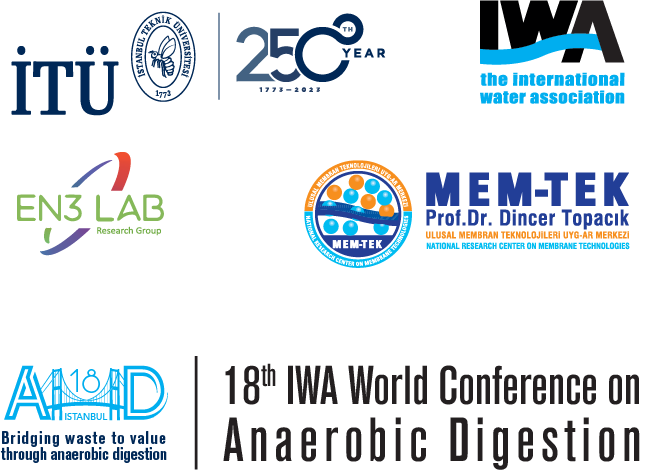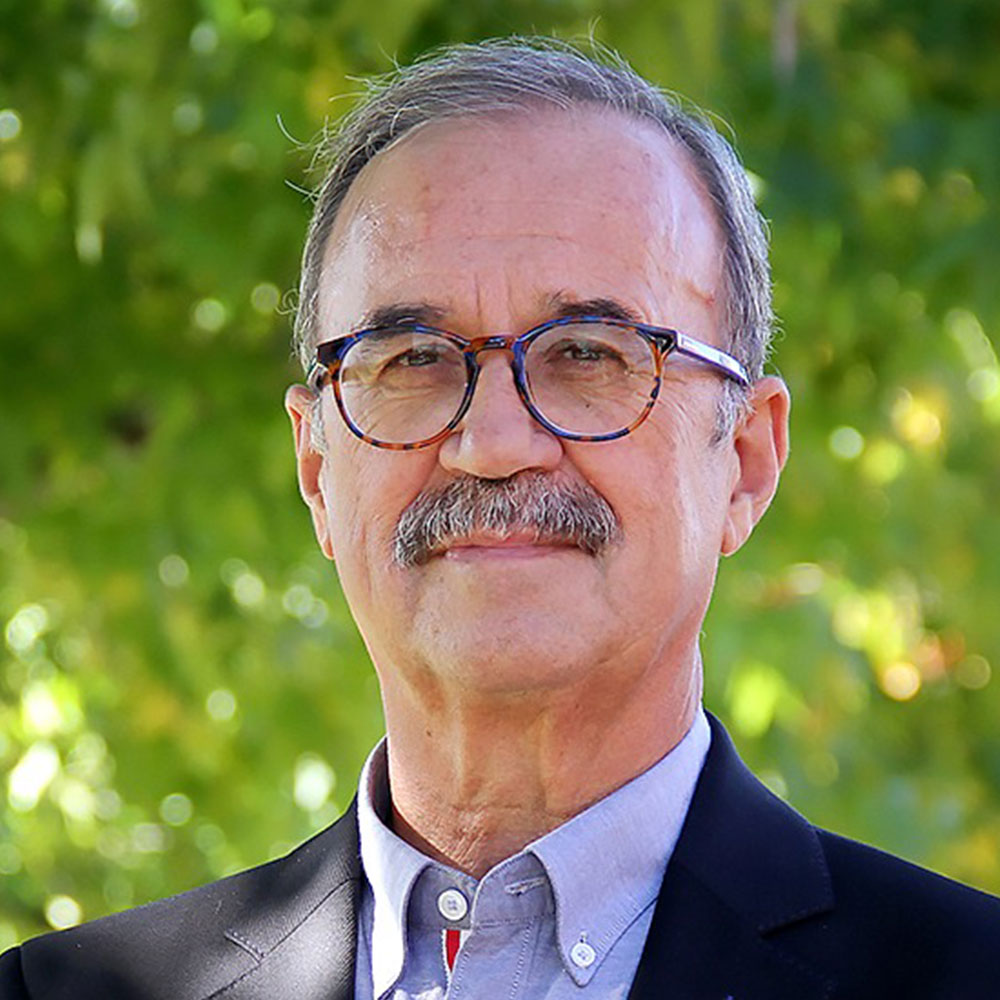
Juan Lema
University of Santiago de Compostela
With a great deal still to do to meet the water supply and sanitation aims of the UN Sustainable Development Goals, there is a practical need for solutions that can be applied at scale and at speed. These aims do feature prominently in the global conversation on water, not least in the UN Water Action Agenda. The question is how to advance the options that respond to the practical need for solutions. The water sector can learn lessons from other sectors about how to unlock the opportunities for game-changing innovations – innovations in which anaerobic digestion technologies have an important part to play. Here, decentralised approaches are key as they allow action at speed, they provide flexibility to adjust as options evolve, and they contribute to resilience. Not only can decentralised approaches contribute in these ways to meeting sanitation needs, they can disrupt the status quo that is focused on centralised approaches, building on successful application to contribute increasingly comprehensive, market-driven coverage.
Workshop title: Integrating membrane processes into anaerobic systems
Workshop chairs: Ángel Robles (Universitat de València, Spain), Jules van Lier (Delft University of Technology, the Netherlands)
Workshop lecturers: Zouhayr Arbib (FCC Aqualia S.A., Spain), Jeonghwan (Jon) Kim (Inha University, South Korea), Dianna Kitt (University of Michigan, USA), Ángel Robles (Universitat de València, Spain), Ran Shang (Biothane-Veolia, the Netherlands), Jules van Lier (Delft University of Technology, the Netherlands)
Event description: Different anaerobic membrane-based alternatives are being regarded as a core technology for moving towards new, highly efficient, and cost-effective, green alternatives for wastewater treatment. For instance, AnMBRs have shown their potential for treating: a) low-strength wastewater in mild or even cold climates by introducing a membrane filtration system for complete retention of biomass; and b) industrial wastewaters commonly associated with extreme conditions such as the presence of refractory compounds and/or high salinity that adversely affect biomass retention or reduce biological activity.
Regarding alternative configurations integrating membranes, coupling filtering blankets (e.g., UASB) with post-treatment membranes offers new perspectives for wastewater treatment, since the bioreactor provides a pre-elimination of suspended solids by entrapment and biodegradation in the sludge bed and thus, reduces the solids load to the membrane, allowing for low membrane process costs to be achieved, while membrane represents a polishing effluent step high providing of a high-quality effluent. On the other hand, dynamic membrane (DM) technology represents other low-cost treatment alternative for wastewater treatment, where the dynamic cake formed on the supporting material acts as barrier for pollutant removal while keeping reduced process costs.
Hence, this workshop pays special attention on key operating issues limiting the widespread application of AnMBR technology. In this respect, the main goal of this workshop is to provide recommendations for the improvement of membrane-based anaerobic systems for the treatment of industrial and urban wastewaters.
Expected outcomes of the workshop:
Outline of the workshop:
| Time | Topic | Chair/Lecturer |
| 14:00-14:15 | Welcome and introduction | Ángel Robles/ Jules van Lier |
| 14:15-15:30 | Part 1: AnMBR as core technology within the Circular Economy | Moderator: Valeria Sandoval (YWP; Universitat de València) |
| AnMBR for widening resource recovery within the industrial sector (20 min + 10 min discussion) | Ran Shang Jules van Lier |
|
| AnMBR for widening resource recovery within the urban wastewater sector (20 min + 10 min discussion) | Zouhayr Arbib Ángel Robles |
|
| Discussion and consolidation (15 min) | All | |
| 15:30-16:00 | Coffee Break | |
| 16:00-17:15 | Part 2: Alternative membrane-based configurations | Moderator: Víctor García (ECP; Econvert) |
| Membrane-based polishing steps for anaerobic fluidized bed bioreactor (20 min + 10 min discussion) | Jeonghwan (Jon) Kim | |
| Dynamic membrane bioreactors (DMBRs) to intensify and expand anaerobic digestion applications (20 min + 10 min discussion) | Dianna Kitt*, Lutgarde Raskin, Tim Fairley-Wax, Steven Skerlos | |
| Discussion and consolidation (15 min) | All | |
| 17:15-17:30 | Q/A and conclusions | Jules van Lier/Ángel Robles |
(* Speaker in this slot)
Workshop title: Anaerobic conversions for sustainable biorefineries
Workshop chairs: Marta Carballa/ Miguel Mauricio-Iglesias
(Universidade de Santiago de Compostela, Spain)
Workshop lecturers: Irini Angelidaki (Technical University of Denmark, Denmark), Robbert Kleerebezem (Delft University of Technology, the Netherlands), Clara Reino (CETAQUA, Spain), Nicola Frison (University of Verona, Italy), Nicola Troiano (Hera Group, Italy)
Event description: Anaerobic microbial transformations are key for the circular economy paradigm as they can use a large variety of substrates and convert them into resources with little energy input while yielding products with a dense/high energy content. In the recent years, the variety of products that can be obtained after an initial anaerobic transformation has increased notably and there are several success stories leading to the production of chemicals, feed, energy, biopolymers… This workshop aims at showcasing the possibilities of anaerobic biorefineries and how linking the characteristics of the available substrates with their design is a key aspect for their success.
Expected outcomes of the workshop:
Outline of the workshop:
| Time | Topic | Chair/Lecturer |
| 14:00-14:15 | Welcome and introduction | Marta Carballa |
| 14:15-15:30 | State of the art: from biogas to biomethane and other value-added products | Irini Angelidaki |
| State of the art: the carboxylate platform up to PHA and medium-chain fatty acids | Robbert Kleerebezem | |
| Team activity: creating new value chains I | Moderated by chairs | |
| 15:30-16:00 | Coffee Break | |
| 16:00-17:15 | Team activity: creating new value chains II | Moderated by chairs |
| Success case 1: Economics and business case for VFA production from sewage sludge and OFMSW | Clara Reino | |
| Success case 2: Production of PHA and nutrient recovery from waste streams | Nicola Frison | |
| Succes case 3: Biomethane upgrading by CO2 + H2 methanogenesis | Nicola Troiano | |
| 17:15-17:30 | Q/A and conclusions | Miguel Mauricio-Iglesias |
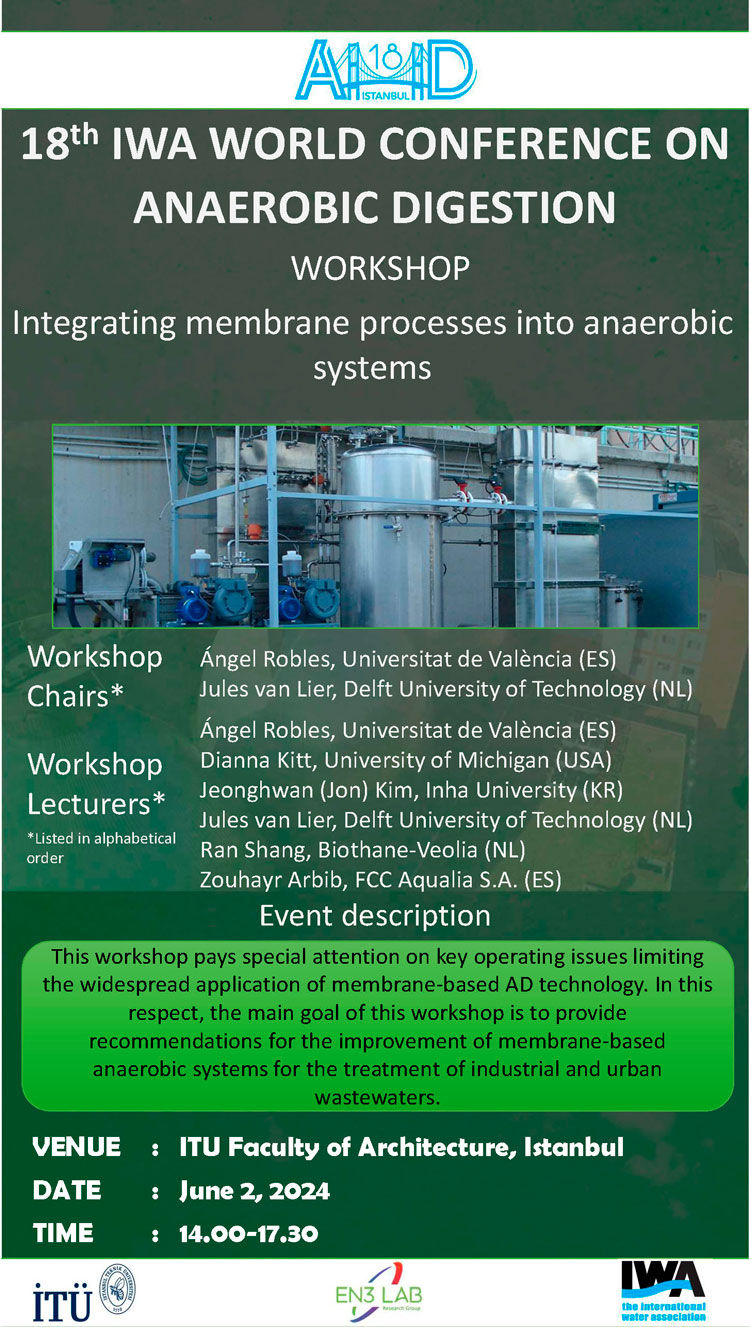
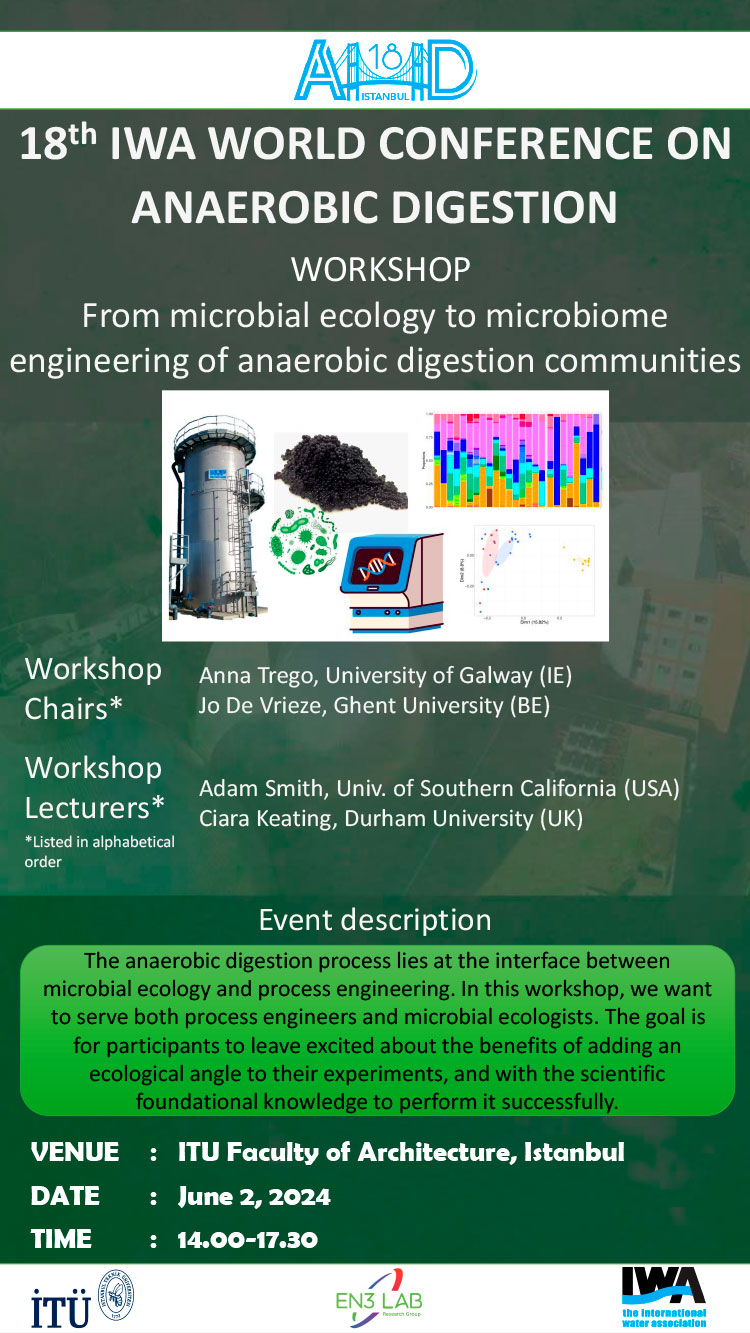
Workshop title: From microbial ecology to microbiome engineering of anaerobic digestion communities
Workshop chairs: Jo De Vrieze (Ghent University, Belgium), Anna Trego (University of Galway, Ireland)
Workshop lecturers: Ciara Keating (Durham University, UK), Adam Smith (University of Southern California, USA)
Event description: This workshop will focus on the microbial ecology of anaerobic digestion (AD) ecosystems. As the work of the AD scientific community lies at the interface between microbial ecology and process engineering, we want this workshop to serve both process engineers (with potentially minimal experience in ecological concepts), as well as microbial ecologists working on applied aspects of AD. We plan to cover fundamental concepts (e.g., lab techniques, sequencing tools, and analytical tools), as well as emerging technologies and approaches at the nexus of ecology and microbiome engineering. We hope to stimulate discussions around experimental planning, the state and future of the ‘field’, and current knowledge gaps in AD microbial ecology. We plan to include a presentation/teaching component, as well as a hands-on component to our workshop. The goal of this workshop is for participants to leave excited about the benefits of adding an ecological angle to their experiments, and with the scientific foundational knowledge to perform it successfully.
Expected outcomes of the workshop:
Outline of the workshop:
| Time | Topic | Chair/Lecturer |
|
14:00-14:15 |
Introduction on the workshop content and objectives |
Jo De Vrieze |
|
14:15-14:35 |
From ecology to engineering: monitoring and steering of AD based on ecological parameters |
Ciara Keating |
|
14:35-15:05 |
Molecular techniques in anaerobic digestion: potentials and pitfalls |
Adam Smith |
|
15:05-15:20 |
How to finetune your experimental design in relation to molecular techniques |
Jo De Vrieze |
|
15:20:15:30 |
General Q&A/discussion |
All |
|
15:30-16:00 |
Coffee Break |
|
|
16:00-16:40 |
What can I do with my sequencing data? Statistical tools and data sharing |
Anna Trego and Ciara Keating |
|
16:40-17:15 |
Ask the experts (roundtable), Q&A and conclusions |
Anna Trego & Jo De Vrieze |
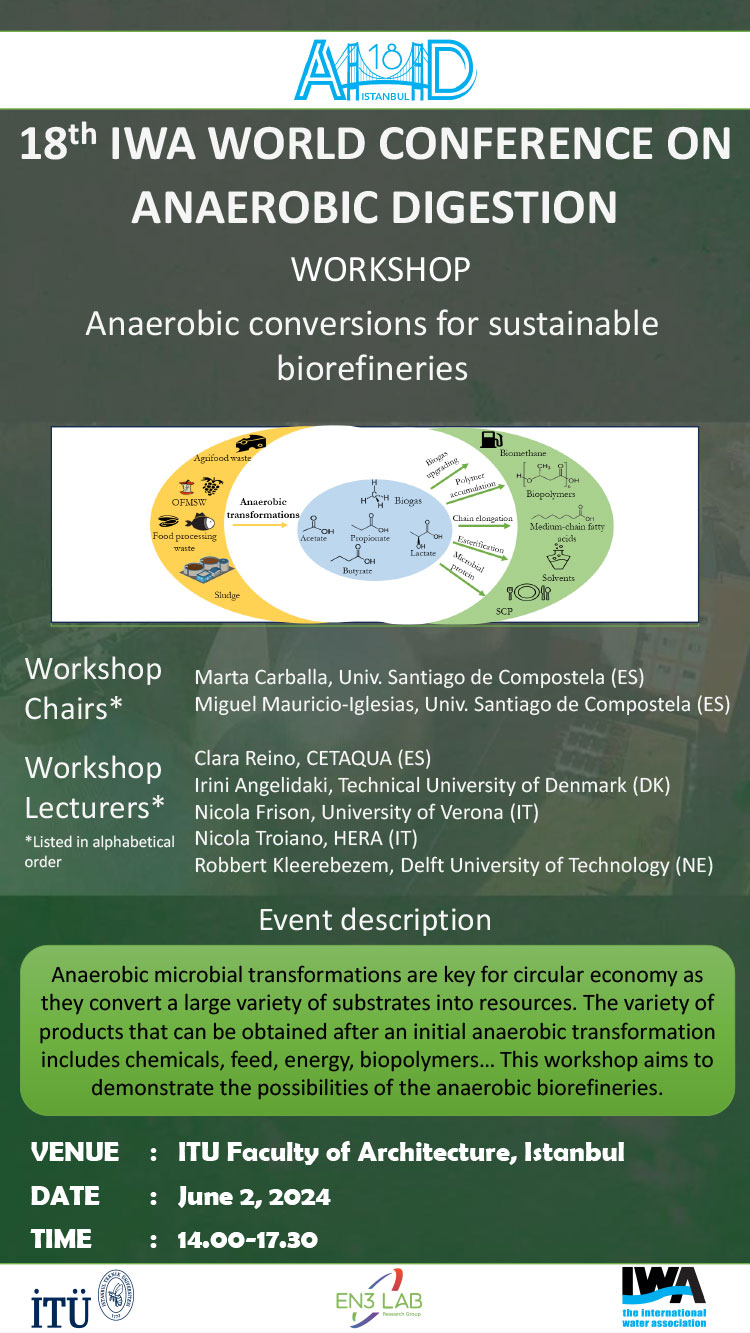
Implementing innovative biotechnologies to recover value-added products with simultaneous waste treatment can provide alternatives to fossil-fuel based products, address environmental problems, and strengthen the bioeconomy. This talk will highlight top-down and bottom-up approaches to harness microbiomes for treating and converting waste streams such as food and brewery waste and lignocellulosic biomass into valuable resources. Chain elongation is one such emerging biotechnology that employs a top- down approach through an ecological selection of anaerobic microbiomes to produce platform chemicals called medium chain carboxylic acids from diverse waste streams. The bottom-up approach will be discussed to systematically study environmental isolates that are potential biocatalysts for lignocellulosic (agricultural) biomass conversion. Integrating top-down and bottom-up approaches for microbiome engineering will ultimately enable us to leverage the diverse metabolic capacity of microorganisms for diverse environmental and biotechnology applications.
The transition from traditional wastewater and waste treatment plants to more advanced processes that enable the efficient recovery of resources has become a scientific, technological, economic, and social challenge. In this regard, anaerobic digestion plays a crucial role as it not only helps reduce greenhouse gas emissions but also paves the way for new industrial development models.
The “Carboxylate platform” is based on transforming biowastes (hundreds of different molecules) by anaerobic fermentation into a few numbers of volatile fatty acids (VFA), including Lactic acid, which are essential to produce useful chemicals. This presentation will delve into the importance of thermodynamic, kinetic, and stoichiometric principles in guiding anaerobic fermentation towards selective production of VFAs. Our research group has developed a metabolic model simulating the anaerobic fermentation process and predicting the VFA production yields under different conditions. The model has undergone a rigorous validation process, using experimental data, and has consistently shown promising results in predicting the optimal conditions for enhancing the selective production of the desired VFA. Furthermore, we will discuss the current state of the art and several pilot or industrial-scale projects that aim to produce VFAs,
Polyhydroxyalkanoates (PHA), and Medium Chain Fatty Acids (MCFA) from a variety of feedstocks, such as agricultural waste, industrial effluents, and municipal solid waste. Finally, the opportunities of the platform based on lactic acid will be analysed.
Anaerobic digestion of sludge and slurries from wastewater treatment plants has been a core topic in AD conferences for many decades. While sludge stabilization was a primary driver, the concomitant energy recovery positioned anaerobic digestion centrally in greening conventional activated sludge (CAS) systems. What is the status of sludge digestion and what are the current developments in application and fundamental research? What limits the bioconversion and what techniques can be applied to maximize this. Thermal hydrolysis processes (THP) are increasingly applied to maximize biogas production, but THP also impacts AD functionalities, sometimes resulting in less biogas than expected. Can we predict the effects? Do we need alternatives for THP? With enhanced sludge digestion, also the reject waters get more concentrated. While anammox is being implemented to reduce the N load, increasing concerns for non-controlled N2O emissions and potential cultivation of Legionella at the treatment sites call for alternative approaches. Step away from biology and embracing physicochemical techniques? Recent research has shown that we can also recover the biochemical energy enclosed in ammonia. May this help in further greening the CAS systems? The introductory lecture aims to vitalize one of the most traditional topics in the IWA World Conferences on Anaerobic Digestion.
Despite the promise of anaerobic biotechnology, its full-scale application to treat certain organic waste streams and recover resources remains limited, suggesting that new approaches are needed to expand its use. This presentation will show the development of new anaerobic bioprocesses by applying knowledge of microbial community structure and function and sustainable technology design practices. This approach will be illustrated by focusing on anaerobic dynamic membrane bioreactor development for treating waste streams containing recalcitrant lignocellulosic compounds.
The thermodynamic end-product of the anaerobic digestion process is methane containing biogas, but many research efforts aim for other products, like volatile fatty acids (VFA), molecular hydrogen, ethanol or lactate. These products represent a higher value in a biobased economy when recovered directly from the fermentation broth or when converted in secondary bioprocesses for the production of medium chain length fatty acids or bioplastics. A prerequisite for development of these processes is the (controlled) absence of methanogenesis to maximize the product yield. In this presentation I will describe how and why product formation in anaerobic fermentations depends on the cultivation conditions imposed. Emphasis will be on the identification of key environmental switching points that determine if (partial) inhibition of methanogenesis will be achieved. To which extent these switching points are independent of the history of the microbial community will be a topic of discussion.
The traditional methods of treating urban wastewater are energy-intensive and contribute to carbon emissions. Anaerobic digestion technologies can be used to reverse the negative energy balance of wastewater treatment. By treating municipal organic waste and wastewater together, energy recovery can be further enhanced. The integration of various emerging concepts in this integrated waste management concept, such as carbon redirection, anaerobic membrane bioreactor, lithotrophic denitrification, post-ozonation, and artificial methane production, holds significant promise for resource recovery and sustainability. This integrated concept will also support the resilience of the urban water supply system against global warming by providing reclamation and reuse of high-quality treated wastewater in dual water distribution networks. A holistic approach that includes these emerging technologies in municipal organic waste and wastewater treatment will be explored in this presentation.
Microbes play a crucial role in facilitating the green transition towards sustainable and eco-friendly practices. This abstract presents various ways in which microbes contribute to develop technologies for the transition from the fossil based economy to bioeconomy. Microbes are are involved in bioremediation, where they break down and detoxify pollutants in contaminated sites, helping restore ecosystems affected by human activities. Additionally, certain microbes possess the ability to produce biofuels and biochemicals, offering a renewable alternative to fossil fuels and reducing greenhouse gas emissions. Furthermore, microorganisms contribute to sustainable treatment of organic waste. Biotechnologies are contributing to valorisation of residual resources, promoting efficient recycling and nutrient cycling.
In this presenation I will show potential applications from biogas to biomethane which can be supplied to the natural gas grid. Methane can also be used as substrate for cultivation of methanotrophic bacterial with high protein content with good aminoacids composition. Additional products can be obtained from the intermediates of the AD process, such as PHAs or specific volatile fatty acids, alcohols, lactic acids etc. Results of several of these alternatives to heat and electricity will be presented. Current status and future opportunities will be discussed.

